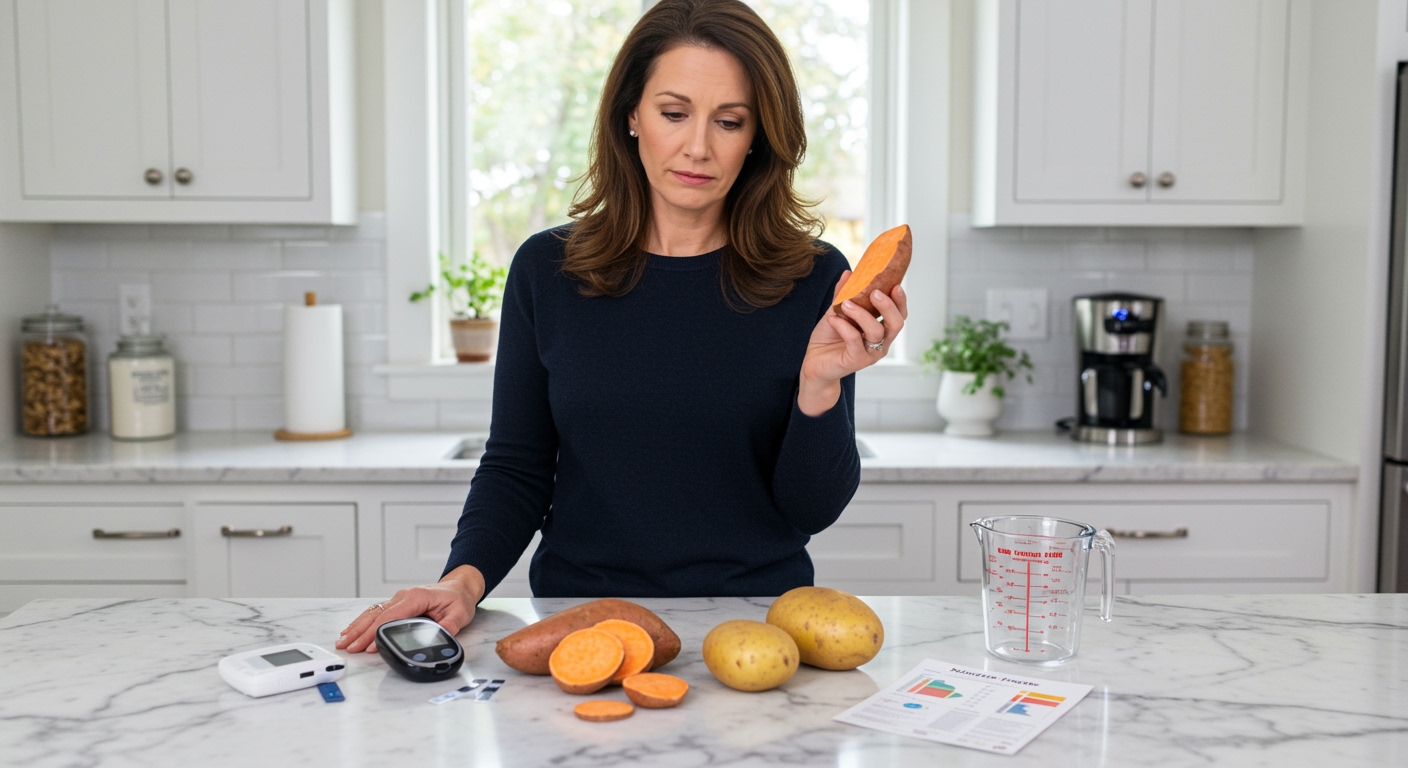✪ Key Takeaway: Sweet potatoes can be good for diabetes when eaten in proper portions due to their lower glycemic index than regular potatoes.
Introduction
You walk down the grocery aisle and see those beautiful orange sweet potatoes sitting next to regular white potatoes.
Your doctor told you to watch your carbs, but everyone keeps saying sweet potatoes are somehow different and better for blood sugar control.
Hi, I’m Abdur, your nutrition coach and today I’m going to explain exactly how sweet potatoes affect your blood sugar and whether they deserve a place in your diabetes-friendly meal plan.
How Do Sweet Potatoes Affect Blood Sugar Levels?
Sweet potatoes have a glycemic index of around 54, which places them in the moderate category compared to regular potatoes that score 78-85.
This lower glycemic index means sweet potatoes cause a slower rise in blood glucose levels after eating.
The fiber content in sweet potatoes plays a crucial role in this slower absorption process.
One medium sweet potato contains about 4 grams of fiber, which helps slow down the digestion and absorption of carbohydrates in your small intestine.
However, the cooking method significantly changes how your body responds to sweet potatoes.
Boiled sweet potatoes have a lower glycemic response than baked or roasted ones because high heat breaks down more starch into simple sugars.
✪ Pro Tip: Cool your cooked sweet potatoes in the refrigerator overnight to increase resistant starch content and lower blood sugar impact.
What Makes Sweet Potatoes Different From Regular Potatoes?
The key difference lies in the starch structure and additional nutrients that sweet potatoes contain.
Sweet potatoes contain more amylose, a type of starch that digests more slowly than the amylopectin found in higher amounts in white potatoes.
The orange color comes from beta-carotene, which your body converts to vitamin A and provides antioxidant benefits that may help protect against diabetes complications.
Sweet potatoes also contain anthocyanins, especially in purple varieties, which research shows may improve insulin sensitivity.
The natural sugars in sweet potatoes are balanced with fiber and other nutrients that help moderate their absorption.
Regular potatoes, while not necessarily bad, tend to cause more rapid spikes in blood glucose due to their higher glycemic index and different starch composition.
✪ Fact: Purple sweet potatoes contain up to three times more anthocyanins than regular orange varieties.
How Much Sweet Potato Can You Safely Eat?
Portion control remains the most important factor when including sweet potatoes in a diabetes meal plan.
A safe serving size for most people with diabetes is about one-third to one-half of a medium sweet potato, which contains roughly 15-20 grams of carbohydrates.
This amount fits well within the carbohydrate counting approach that many diabetes educators recommend.
Your individual tolerance may vary based on your current blood sugar control, medications, and overall insulin sensitivity.
Testing your blood glucose 1-2 hours after eating sweet potatoes helps you understand your personal response.
Pairing sweet potato with protein or healthy fats further slows digestion and helps prevent blood sugar spikes.
For example, having sweet potato with grilled chicken or a handful of nuts creates a more balanced meal that supports stable blood glucose levels.
✪ Note: Always consult your healthcare provider before making significant changes to your diabetes meal plan.
What Does Research Say About Sweet Potatoes And Diabetes?
Several studies have examined the relationship between sweet potato consumption and blood sugar management in people with diabetes.
Research published in academic journals shows that sweet potatoes may help improve insulin sensitivity when consumed as part of a balanced diet.
One study found that the fiber and antioxidants in sweet potatoes contributed to better glucose tolerance compared to refined carbohydrate sources.
The resistant starch content in cooled sweet potatoes has been shown to feed beneficial gut bacteria, which may indirectly support better blood sugar control.
However, researchers consistently emphasize that portion size and preparation method significantly impact these potential benefits.
The evidence suggests that sweet potatoes can be included in a diabetes-friendly diet, but they should not be considered a therapeutic food that actively treats diabetes.
✪ Fact: Resistant starch acts like soluble fiber and can improve insulin sensitivity over time with regular consumption.
The Bottom Line
Sweet potatoes can be a good choice for people with diabetes when eaten in appropriate portions and prepared using methods that minimize blood sugar spikes.
The best foods for diabetes are not magical superfoods, but everyday foods eaten in the right amounts at the right times.
I would love to hear about your experience with sweet potatoes and blood sugar management, so please share your thoughts or questions in the comments section below.
References
At NutritionCrown, we use quality and credible sources to ensure our content is accurate and trustworthy. Below are the sources referenced in creating this article:
- PMC: Sweet potato and diabetes research
- Signos: Sweet potato glycemic index
- Rise Nutrition: Why sweet potatoes have lower glycemic index
- Oxford Academic: Sweet potato nutritional properties





